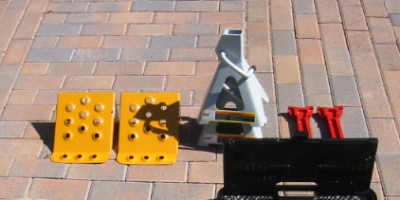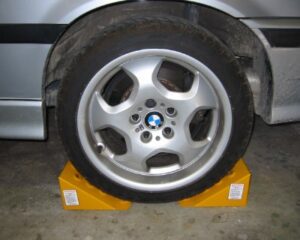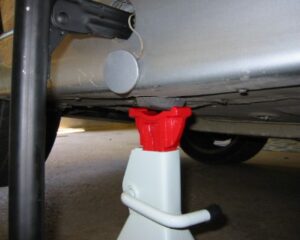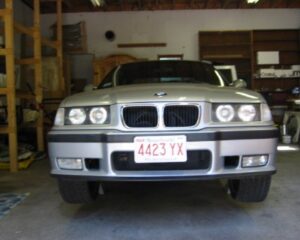Article by: Adam B. Hocherman
Article applies to: all BMW e36 M3 models (and probably others).
Proper jacking of your M (or other 3-series BMW sedan) is very simple. Refer to the list below for necessary parts and costs:
Required tools:
- 2 (one set) 2- or 3-ton jack stands. ($20)
- 2 (one set) of wheel chocks. ($10)
- 1 small wooden block. (free)
- 1 factory jack stand. (free w/ purchase of BMW)
Total tool cost:
$30

Step 1: Chock The Rear Wheel
The first step is critical and should not be omitted.
On a flat, level surface, place one wheel chock in front of and one behind the same rear wheel as shown in figure 2, below.
Again, the wheel chocks both go on the same side which prevents the jacks from swinging forward (or rearward) when you are torquing on a bolt.

Step 2: Jack The Car Using The Factory Jack And Wood Block
Adjust your jack stand to an appropriate setting for your car – likely the lowest setting. Do not let the sliding portion (red) of the jack stand rest on the lip of the lower portion (grey) – use the ratchet mechanism provided and choose the lowest setting instead.
Start on either side and remove the small plastic cap from the jack access point towards the front of the vehicle. Jack the car according to the factory procedure (see owners manual if you have not done this before) using the small wooden block if to gain additional clearance if your jack stands are a little too tall for the factory jack. Jack the car just high enough to slide the jack stand under the hockey puck-shaped jack stand mounting point.
With the jack stand properly positioned, slowly lower the car onto the stand ensuring that the top of the stand positions in the middle of the hockey puck mounting point.

Step 3: Repeat
Perform the same operation on the far side of the car.
Step 4: Check Wheel Chocks
With the front of the car properly jacked, ensure that the wheel jocks are pushed snugly up against the rear tire. You’re done!

